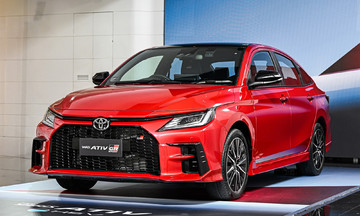Most electric vehicles operate more smoothly and quietly than gasoline-powered cars, creating a comfortable experience for drivers. However, this isn't always the case for those in the passenger seats. Many wonder if it's normal to feel carsick in the back of an electric vehicle.
According to scientists, experiencing carsickness in an electric vehicle is entirely possible. People can feel carsick even when the electric vehicle isn't being driven at its full potential, even if they are used to traveling in combustion engine vehicles without any issues.
"Increased carsickness in electric vehicles may be due to a lack of experience, for both the driver and passengers, where the brain can't correctly estimate movement forces because it relies on prior experience driving other types of vehicles," said William Emond, a doctoral candidate at the University of Technology of Belfort-Montbeliar in France.
 |
The electric vehicle experience has different elements compared to combustion engine vehicles. Photo: GreenCars |
The electric vehicle experience has different elements compared to combustion engine vehicles. Photo: GreenCars
Though electric vehicles are growing in popularity, combustion engines still dominate the roads. Drivers have had years of experience with gasoline-powered cars, giving them more time to adjust to their specific cues. If someone has spent most of their life driving a combustion engine vehicle, their brain will anticipate the acceleration after the engine revs, alerting them to an impending change in speed. In a battery-powered vehicle, the electric motor doesn't produce such auditory cues.
Beyond general unfamiliarity, research has identified a link between the specific characteristics common to electric vehicles and motion sickness. A 2024 study concluded that there is a strong correlation between motion sickness levels and the vibrations of electric vehicle seats, while a 2020 study found the absence of engine noise in electric vehicles could be a key factor contributing to increased feelings of carsickness.
"If we're used to traveling in non-electric vehicles, we're accustomed to understanding the vehicle's motion based on cues like engine revs, engine vibrations, and torque. However, traveling in an electric vehicle for the first time presents a new movement environment for the brain, requiring adaptation," Emond explained.
Additionally, regenerative braking, used in electric vehicles, converts the kinetic energy of the slowing car into electrical energy, which is then stored in the battery. This results in a gradual and consistent deceleration over a longer period, rather than a rapid or jerky stop. Such low-frequency deceleration tends to be linked to higher levels of motion sickness.
A 2024 study suggested that this feature acts as one of the primary contributors to carsickness in electric vehicles. The study's authors wrote, "Our results confirm that higher levels of regenerative braking can induce motion sickness".
Carsickness is thought to be caused by a mismatch between the different sensory signals the brain receives simultaneously about the body's motion. Specifically, this occurs when the inner ear, which helps control balance, the eyes, and the body send conflicting information to the brain.
"Better knowledge of self-motion allows us to anticipate movement forces, which is critical for motion sickness. However, when the movement forces estimated or predicted by the brain differ from what is actually experienced, the brain interprets this ‘neural mismatch’ as a conflict situation," Emond said. "If this conflict persists over time, it can exceed a threshold, triggering the body’s autonomic responses, such as the overt symptoms of ‘motion sickness’".
Being able to predict a vehicle's movements seems to be an integral part of the motion sickness experience, which is why drivers don't tend to experience symptoms. They know what’s coming.
The interplay between motion prediction and actual motion experienced may be why electric vehicles are linked to worse carsickness, as these vehicles provide fewer clues about impending movements.
"When exploring a new motion environment, the brain needs to acclimatize because there’s no prior experiential knowledge in such a context. For instance, this is why almost everyone gets sick in zero gravity," Emond said.
As electric vehicle ownership continues to rise, some researchers have explored solutions for this specific type of nausea. Several research papers have suggested that motion sickness in autonomous electric vehicles might be treated using visual cues, such as interactive displays and ambient lighting, or vibration signals to allow passengers’ brains to predict changes in motion, lessening the queasiness of being in the back of an electric taxi.
My Anh (Guardian)











